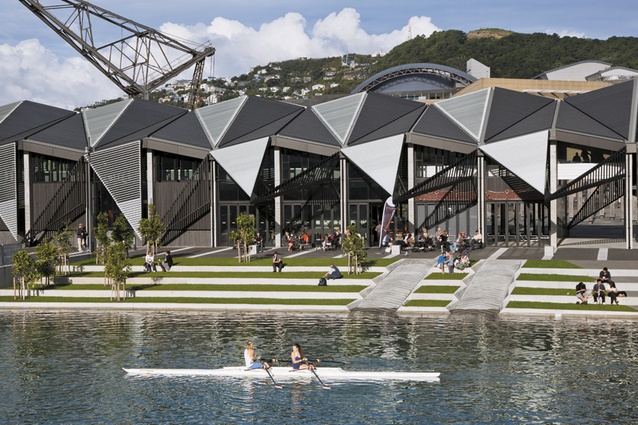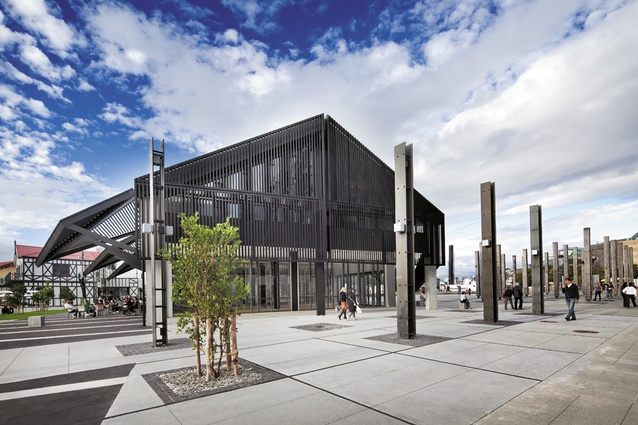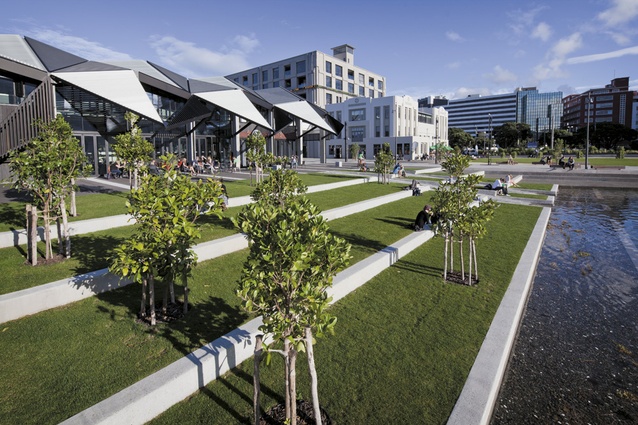New urban design for Wharewaka Precinct
Athfield Architects and Wraight + Associates discuss the urban design concepts around one of Wellington's newest and most recognizable public buildings.
Before the wharewaka was built, northerly winds cut through the gap between the Star Boating Club and the Wellington Free Ambulance Building, the site of St Johns Heineken Hotel. The now-sheltered space has attracted many people since the new building opened at dawn on Waitangi Day this year. The two waka for which part of the building was created have not yet materialised (the subject of a dispute between Wellington City Council and Waiwhetu Maori) but then neither has the thin, light bridge, planned long ago to link Civic Square and Te Papa. But while some connections are taking time to make, Wellingtonians are claiming their new playground.
The west-facing wharewaka terraces and St Johns’ lawn are the main recreational spaces. The concrete terraces are planted in lawn and a few karaka trees, which give way to gravel and endemic coastal grasses as they approach the water’s edge. Two runways will help launch the ceremonial waka and waka ama (outrigger canoes) into calm water. The lagoon was widened and deepened to take boat traffic, its final shape largely determined by the geometry of four different axes that join at this point.
Fundamental principles underpinning the Lambton Harbour Public Spaces Master Plan of 1997 inform the project. The intention is to make the city-water connection in three distinct ways by “allowing more public interaction with the water’s edge through cut-outs, pontoons and constructed rocky edges, retaining and enhancing motivating views between city and the harbour and creating a welcoming edge along the waterfront Quays from both land and the water”.
Landscape architects Wraight + Associates are responsible for completing what Megan Wraight calls “the final part of the Taranaki puzzle”. The company has worked with Athfield Architects on this and several other waterfront projects that include Waitangi Park, the waterfront promenade along the breastworks of Te Papa to Taranaki Wharf and the proposed Frank Kitt’s Park.
“This is quite a complicated corner of Taranaki Wharf,” says Jeremy Perrott, from Athfield Architects. “There are so many intersections. One of the challenges from a very large planning point of view was getting these to work.”
Six lanes of Jervois Quay curve around what used to be the edge of the old sea wall; the West Taranaki and city to sea promenades form other axes, and Taranaki Wharf is on yet another angle.
Around the wharewaka, planting, materials and other elements link with the natural, cultural and historical elements of the area. A karaka grove was planted inside an enclosure beside the building site ten years ago. Usually only pohutukawa grow above bush height on the exposed coast, however, the grove has flourished.
“We were told nothing was going to grow,” says Wraight. “But by planting in a grove with some shelter initially the trees now self-support. They’re away.”
Karaka trees signal an occupied space for Maori. Traditionally they would plant them, often in groves, when arriving in a new area. The trees were a source of food and may represent the spirits of ancestors. Planting – on the wharewaka terraces, on ‘Treasure Island’ next to the Star Boating Club and in Waitangi Park – is particular to the harsh environment of the region; the grasses self-seed and thrive.
There is a materials selection logic for the area around Taranaki Wharf, which is repeated in Waitangi Park. The palette for the wharves was retained as asphalt over the wharf structure and the structural elements revealed. Timber inlays reflect these elements; two wharf cut-outs, popularly dubbed ‘Andy Wharf-hole’, were added next to Circa Theatre and Te Papa. A ‘timber garden’ made of wharf timber recycled from the cut-outs is a feature of Odlins Plaza. These form vertical markers that link through to Te Papa and draw people into the space. They are designed to take guy ropes for market tents, and can be taken down to make room for event marquees. Taranaki Wharf was one of the first built in Wellington although prior to the project it couldn’t be read as a wharf, Wraight says. A hundred years ago the Odlins building was built where land met sea and boats would disgorge their cargo of logs for processing.
“The land had been filled in behind it in such a way you couldn’t see where the wharf ended and started. The reference back to its heritage has been to create this very strong edge along Taranaki Wharf to identify it as the wharf.”
History links the statue of Kupe, at the north-facing entrance to the wharewaka, with the Wellington Free Ambulance Building. They both date from 1940 when the Centennial Exhibition of Wellington was held in Rongotai. Afterwards, the plaster statue stood for many years in the Railway Station and has been cast in bronze for the waterfront location.
Wellington Waterfront has undergone various permutations since the Lambton Harbour Public Spaces Master Plan was drawn up in 1997. The design was amended following a public consultation process and there have been other changes in response to lobbying.












